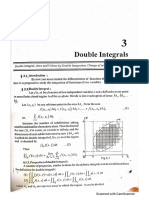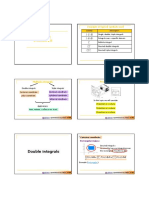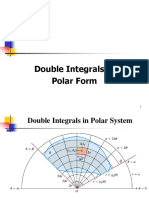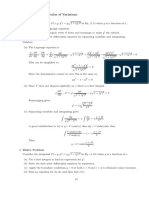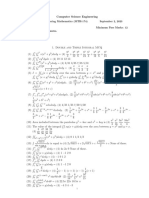0 ratings 0% found this document useful (0 votes) 47 views 21 pages Change of Variable (Part of Unit 3)
The document discusses the change of variables in double and triple integrals, emphasizing how transformations can simplify evaluations. It provides examples of converting Cartesian coordinates to polar coordinates and illustrates the process using various integrals. Additionally, it covers the calculation of areas and volumes using integration techniques, along with examples for better understanding.
AI-enhanced title and description
Copyright
© © All Rights Reserved
We take content rights seriously. If you suspect this is your content,
claim it here .
Available Formats
Download as PDF or read online on Scribd
Go to previous items Go to next items
Save change of variable (part of unit 3) For Later 4.6. CHANGE OF VARIABLES
Quite often, the evaluation of a double or triple integral is greatly simplified by a suitable
change of variables.
Let the variables 2, y in the double integral She flee, y) dx dy be changed to u, » by
means of the relations x = 6, v), y = wlu, »), then the double integral is transformed into
ae ae
JJ, fom: ylu.0)} Ld [dudvwhere s= 2&2 = au 00 | is the Jacobian of transformation
eee au.) | ay ay
ou dv
from (x, 9) to (u, v) co-ordinates and R’ is the region in the uv-plane which corresponds to the
region R in the xy-plane. j,
(i) To change cartesian co-ordinates (x, y) to polar co-ordinates (r, 8).
Here we have x =r cos 0, y =r sin 0 so that x? +
& &
cosé —rsin@
J = » sin6 reos@ |=" (cos?@+sin? 6) =r
or 08
Jf roasaeay= [Jp fercos0, rsin rar |
ie, replace x by r cos 0, y by r sin ® and dx dy by Zz
rdrdé. t
Py?)�EEE
Example 1. Evaluate the following by changing into polar coordinates:
rc ya? dey vA
oto
Sol. Changing to polar coordinates by puttinge=r
‘0s and y=r sin @ so that x” + y? = 1, we get
= [fe sin? @.r.rdrd0
r 5\e
=| |4] sin? odo
i, 5),�Example 2. Change into polar coordinates and evaluate I jl el! dydx, |
Hence show that Se (A.K-T.U. 2015, 2019)
A
Sol. For the region of integration in cartesian co-ordinates, y varies from 0 to = and x
also varies from 0 to . Thus the region of integration is the plane XOY. Changing to polar co.
ordinates by putting x =r cos @, y = r sin @ so that x” + y? = r?; for the region of integration
. r
r varies from 0 to ~ and @ varies from 0 to >.
a [fee aas= [fee rarao
is ae e-'dt do, where t = r2
n/2
1 pre 1 ©
wade we =-|0 =—
ah (0-1) do ale, 7
Now, let I je dx
Between the same limits, we have
=e" d
T=[ve% ay
r=[["
= fie
vn
= IT
dx dy = whee +9) de dy =1 | Proved already
27�2 pfx — x
Example 3. Evaluate J ; xdy d_ 5) hanging to polar coordinates.
Sol. In the given integral, y varies from 0 to 2x - x? and x varies from 0 to 2
Qx-x® => x+y? = 2x.�yuuTIPLE INTEGRATION 353
Inpolar co-ordinates, we have r? = 2r cos 0 or r= 2.cos 6.
For the region of integration, r varies from 0 to 2 cos @ and 6 varies from 0 to =
In the given integral, replacing x by r cos 8, y by r sin @, dy dx by r dr d0, we have
_ pr2 p2e88 rcos@.rdrd@ _ pr? prease
i= ff f renee n=l [reser ao
2
m2 Pens m2 24
= ES =f” 3 =9.fs=
i enol F. de 5 2cos* @d0 =2 373
Example 4. Evaluate J J qa? —x? — y? dx dy over the semi-circle x? + y? = ax in the
positive quadrant.
Sol. Changing to polar co-ordinates, x° + y’ = ax transforms into r = a cos 6. For the
. t . ir
region of integration R, r varies from 0 to a cos @ and @ varies from 0 to 2
Sha la? — x" —y? de dy
= [Ope rar ao
< Pp se —72)¥? (2n) dr dO
0 Jo 2
cas 8
=f" @- | aa
o 2 | 3/2 |,
3 fe sin? 0-a*) do = Dae
340�2
Example 10. Evaluate {f+ y)® dx dy, where R is the parallelogram in the xy-plane
with vertices (1, 0), (3, 1), (2, 2), (0, 1), using the transformation u =x +y and v =x 2y
(AK-T.U, 2020)
Sol. The vertices A(1, 0), BG, 1), C2, 2), D(, 1) of the parallelogram ABCD in the xy-plane
become A’(1, 1), BG, 1), C’(4, ~ 2) and D‘(1, — 2) in the uv-plane under the given transforma-
tion. g
‘The region R in the xy-plane becomes the region R’ in the uv-plane which is a
rectangle bounded by the line uw = 1, u=4 and v =—2, v= 1. Solving the given equations for x
andy, we have x= j (Qu +0), y= $(u—v)
jax ax| [2 2
ax,» _|au a\_[3 3\--1
J= tw,v) © | oy oy. J -4 a
au av| 13 38
Pix" aedy = [fat sidnae= [fl ot gan
sy} 4 seit Bi
= fag] w= [rents 21
. oJ�(ii) Using the transformations Sy = uy ile show that
[ i ete dy d= (e-D
a�i) Since
=u(l—v), y=uv
ox ax
22) Ju w
T= u,v | ay oy |=
du dv
dxdy=|J | dudv=ududuv
0 = u(l-v)
> uv
xtys => us
Hence the limits of u are 0 to 1 and the limits of v are 0 to 1.
“ fre ity) dy de=f f° et’ |S] du dv
Also,�Example 18. Evaluate by changing the variables, ff, (x+y)? dx dy where R is the
region bounded by the parallelogram x + y =0, x+y = 2, 8x— 2y =O and 3x— 2y=
(AK.T.U 014, 2021)
Sol. Let x+y=uand 3x—2y=v so that
z= Ouse) and y=7(u-0)
ole
n
= 9%») =
Ou, 0)
Now,
er] oon] to
Te
u
1
I
a
f
1
1
dxdy=|J | dudv=zdudv
The limits then become u=Otou=2 and v=Otov=3.
, oe ya
Given Integral 1= ff, ¢+99? deay = ft geen
nla�4.7. AREA BY DOUBLE INTEGRATION
(a) Cartesian Co-ordinates. The area A of the region bounded by the curves y = fi.
efile)
f,(2) and the lines x= a, x= b is given by A= j j, dy de.
‘The area A of the region bounded by the curves x= f,(), «= f,) and the lines y=,
d pfzty)
is given by A= J 5, ” de dy.
Je Sr
() Polar Co-ordinates. The area A of the region bounded by the curves r = (6
7
B pfs)
f,(@) and the lines @ = 0, @ = is given by A = j i i ara.
4.7.1. Area of Curves Given by Parametric Equations
We know that the area between the curve y = f(x), the axis of x and the ordinates at x=a
» »
and x = b is equal to J ydx or [fe de.
Also, the area between the curve x= /(#), the y-axis and the abscissae y=a and y=bis
3 ‘6
given by [x dy or Jf ay.
In case of parametric equations, the above formulae will be replaced by
Bde B dy
a ae dy
Sica ae or ar at
where o: and B are values of ¢ corresponding to the values a and b of xr y.�| 3
ILLUSTRATIVE EXAMPLE:
Example 1. Find the area lying between the parabola y = 4x x? and above the line
™ i (A.K.T.U, 2020)
Sol. Let two curves intersect at points whose abscissae are given by 4x — x! = x
or -8r=0 fe, x= 0,3.
Using vertical strips, the required area lies between x= 0, x=3 and y= x,y = 4x2
7"
Required area = J cc “de
ax x” t
3 {
= f [>] dx (A (3, 3)
=f) Gr-x? ode =P x24 dx *
0 o
2 3p
-[F-4] = 2) _go4s, .
3), 2 a .
Example 2. Find the smaller of the areas bounded by the ellipse 4x° + 9y
straight line 2x + 3y = 6.
36 and the
(1)
2
Sol. The equation of the ellipse is _
| ‘nd the line is 2)
Both meet x-axis at A(3, 0) and y-axis at Ye
“2. Using horizontal strips, the required area
“* between
3
Speen 3 ar and y=0,y=2
3
2
Required area = j fr
,
2
= [aay ~(-yldy Pe
|
A�/ 368 A TEXTBOOK OF ENGINEERING MaTHEN
og
2
2
oe ȴ
2 2%]
lo
Teen! AT. = 3(2.Z-2) =3 -2)
= plasin" a)—4+2)= 9 (2.5 gm
Example 8. Determine the area of region bounded by the curves xy = 2, 4y =22, 5.4
UPTV. 2014, 2015)
Sol. Required area of shaded region
=f aw
‘
“1 (6-8
9 4
2 (3 log »)
3 1
(fe
2
= 3 stog2
Example 4. Find the area bounded by the parabola
9? = 4ax and its latus rectum.
Sol. Required area
= 2(area ASL)
=2 Cf ay ax
=2 [we ax
3?
-us( 8�4.9. VOLUME AS A TRIPLE INTEGRAL
The volume V of a three-dimensional region is given by V= fff, dx dy dz
If the region is bounded by z = f(x, 9), 2 = f,(x, 9); y = 0, (%), ¥ = $.(x) and x=a, x=b
ve freee dz dy ds
lex) Mx»)�| ILLUSTRATIVE EXAMPLES |
| ini
Example 1. Calculate the volume of the solid bounded by the surface x = 0, y = 0,
xty+e=landz=0. (A.K.T.U. 2021, 2019)
Sol. Required volume = [Kop dy dx = [fas nae
=f {a-s?
1 1
=- gla =3
. an 2. A triangular prism is formed by planes whose equations are ay = bx, y =0
and x =a. Find the volume of the prism between the planes z = 0 and surface z = c+ xy.
(G.B.T.U. 2010)
Sol. Required volume = i ee? dz dy dx
= in (c+ 2y) dy dx = f [o+3 ) dx
a el 2 2\%
=f oe YT alae fe) 4 OE (xt
oO a 2a’ a 2), 2
2a?
= te Oa (40 4 ab)
2 8 8
Example 3. Find the volume of the cylindrical column standing on the area common {0
the parabolas x = y2, y = x’ as base and cut-off by the surface z= 12+y-x°. (U.P.T.U. 2014
Sol. Required volume = [" asf af?” -
ye ),�INTEGRATION
uc TiPlt
375
Ys
st (aceg- ene sy )
5 td -1t Est) /
‘os
%
0
xX
peal alles 5g aos
alt eicaiteceias�4.10. CALCULATION OF MASS
(a) For a plane lamina of area A, if the density at a point P(e, y) be p = f(x,y), then its total mass
Misgivenby M=[f, pdedy=ff fix) dxdy
In polar co-ordinates, if p = f(r, @) at a point P(r, 6), then
M= Jfjprarao= ff fee rdr ao.
avity then,
J py dx dy
‘ff paray
Also, if (¥, ¥) is the required centre
ff px dx ay
[Ppa
In polar coordinates,
J p.rcos).rdr do fj p.rsin@.rdr de
fil prarde ‘fff p-rarae
x=
where p is the density.�=
380 {A TEXTBOOK OF ENGINEERING MATHEMATicg
() For a solid of volume V, ifthe density at a point PG 9,2) be p= fbx 9, 2), then its tora
mass M is given by J
M= She de dy de = fffre y, 2) dx dy dz.
| wLusTRaTive EXAMPLES
Example 1. Find the mass of a plate in the shape
Pe rays
of the curve (2) + (2) = I, the density being given
by p= yay.
"Sol. Let the required mass be M which is four
times the mass in the first quadrant.
From the equation of the curve
By
2/9 8/2
7 vol-(2) a)
a
For the region OAB, x varies from 0 to a and y varies from 0 to y,.
M=4[[edrdena f Pusvdyde
= Loe] am font
ol [ey]
Put —-x=asin* 9, then dx = 8a sin? @ cos @ d0
When x=0,0=0; when
M= ous "2
2ub* [7a sin® @ (1 sin? @)° 3a sin? @ cos 6 dO
_ 2 ,
= bua? j sin’ @ cos’ 0 d0 = Gua’? 42-642 __ ae
: 12-10°8-6-4-2 20
densit ample 2, Md the mass of a lamina in the form of the cardioid r = af + cos 8) whose
pak any pel varie ae the square of its distance from the initial line.
Let the required mass be M which is twice the mass above the initial line
Since the distance of i nass :
given by ince of any point (r, 8) from the initial line is r sin 0, the density at ("> ® *
P=H(rsin 6)? =p 7? sin? 9,�nee INTEGRATION 381
mi ‘
e region above the initial line, 0 varies from r=a(1 +008 6)
ch
Re from 0 to a(1 + cos @)
andr varies
M
oto
ge dr do
=2 Ker r sin? @ dr d0
poe
- Eps? 6.0‘ (140080)! do
_ dat (5 8 coe 8) fs
“2 (25m) (200
0 = 32a" f* sin? $ cos cos? ® pao
Put $ =1, then do = 2d" When 0=0,t=0;whenO=m,t= 7
1:9-7-5-3-1
214
oS rat
12°10°8-6-4-2
a
= Spat aid cost ake imatiad
M=52ua' ["" 2sin? ¢ cos”? ¢ dt = G4ua a
wll
4.41. CENTRE OF GRAVITY (C.G.)
(a) The C.G. (&,¥) of a plane lamina occupying an area A in the xy plane and
having density p = f(x, y) is given by
de d3
ff, soda ff, vee
JJ, pasay "ff pated
In polar co-ordinates, if p = f(r, @) at a point P(r, 0), then the C.G.(¥, ¥) is given by
Sf 0088.pr dr do Sh, 7? cos pdr d0
Sf prdrdo Sh prdrd@
y=
JJ, rsinoprar ao 7 sin Op dr de
Sf prdrd® SI, pr dr do
(6) The C.G.Cz, ¥, 2) of a solid occupying @ volume V and having density p = Ax, ¥
fiven by
Sffxoaeay de Sh ypdxdy dz ~MNe zpdxdydz
Jf paedyae *” , ff pdeinds hh pax dy dz
Be
2)is�382 A TEXTBOOK OF ENGINEERING MATHEMay,
es
B peat
E . A plate in the form of a quadrant of the elli (2) (z =i
Example 8. A plate in the form of a quadrant of the ellipse (*) (2) = 1 isoFsmay
but varying thickness, the thickness at any point being proportional to the product of the dista
of that point from the major and the minor axes. Find the co-ordinates of the centre of gravityey
9
the plane.
Sol. Let OAB be the quadrant of the ellipse “> +25 = 1 with OA =a and OB =p
a
If P(x. y) be any point on the plate, then density
from 0 to aand y varies
¥) be its C.G., then
cee
Let Gi
oF ay de
co
a pib/adfa® x
ge pay dx 15
Hence G+ (2.2
15°15
>�Example 6. A triangular thin plate with vertices (0, 0), (2, 0) and (2, 4) has density
p=1+x+y. Then find:
(A.K.T.U. 2021)
(i) the mass of the plate
(ii) the position of its centre of gravity G.
Sol. (i)
B2, 4)
Mass = jj pdx dy
u
if [asxtndvae
, ee
flarns-2] dx
lo
2
M= fl ax+4x*) de�MULTIPLE INTEGRATION
385
“i Jforavdy 9
Af fa xty)xdyde
3 2 32 ?
=— + 4x?
ah aa ede = 5 (20° +04) =
0
_ 3 pape
of -ahe (4x49) ydyde
aq
3
dx =F 2,8
, ah [arn Stee


